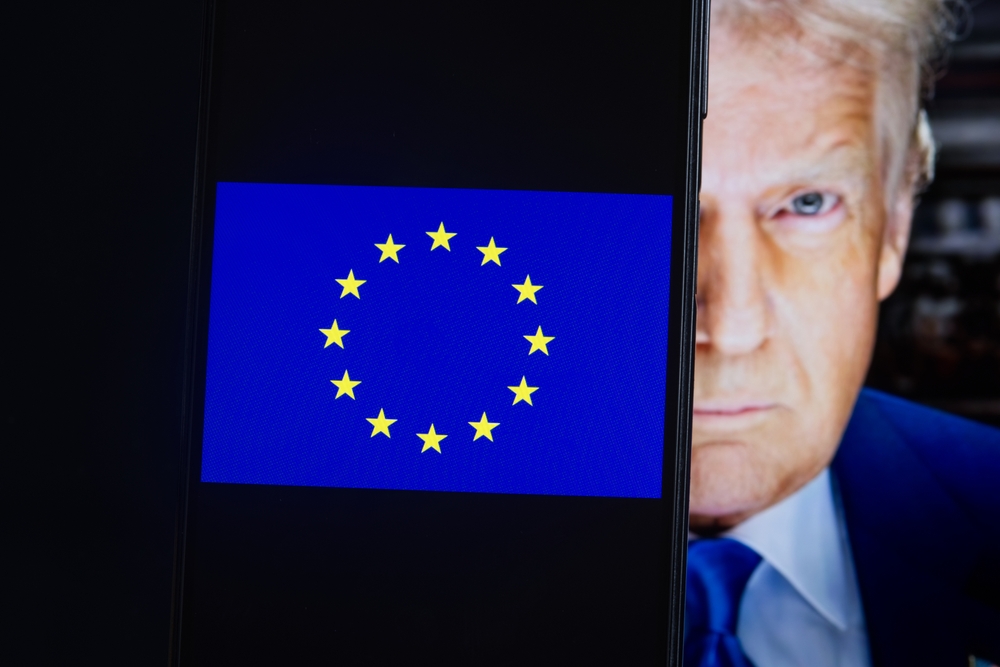
Donald Trump's tariffs have caused volatility and pose problems for your business. Editorial credit: Below the Sky, via Shutterstock.
Donald Trump outlined a sweeping package of trade tariffs on “Liberation Day”, 2 April. Intended to protect the American consumer from the supposedly punitive practices of trading partners, the tariffs range from 10% to 49% and target economies of all sizes – even an island in the Southern Sea inhabited only by penguins.
Few businesses will be able to sidestep their impact. As such, it’s crucial to not just understand tariffs but to have a comprehensive plan in place to insulate your cashflow and profits from the fallout. This article is the first of several tackling the thorny issue of tariffs, so watch this space for more analysis in the coming weeks and months.
A crude policy tool
As he has often done in the early days of his administration, Trump used visuals stuck onto a plastic board to illustrate his momentous decision. If he wanted to convince markets of the fully formed economics that underpinned his policy, this was not the way to go about it.
Analysts were shocked by how the tariffs had been decided. After some scrambling and confusion, it turns out the tariffs imposed on countries around the world were calculated simply by dividing the American trade deficit with that country by the total goods imported. This was far simpler (and far less convincing) than what many had expected, leading to fears it could spark a confidence crisis in the US dollar.
There is a flat 10% tariff rate on all goods entering the country. This means that even places like the UK, with which the USA has a healthy trade surplus, face charges. You can find a list of some of the key tariffs listed below.
| Country | New US tariffs, % | ‘Tariffs charged to the USA” |
| Cambodia | 49 | 9 |
| China | 34 | 67 |
| European Union | 20 | 39 |
| Israel | 17 | 33 |
| United Kingdom | 10 | 10 |
| Vietnam | 46 | 90 |
Like a lead balloon
The reaction in financial markets was brutal. Wall Street suffered a $2.5trn rout that extended to blue chip giants like Apple. Exchange rates swung violently and there seemed to be little consensus as to Trump’s aims, or what impact his decisions would have.
Some of Trump’s decisions (like the aggressive tariffs levied on the European Union, for example) had been expected. What was really damaging to confidence was the decision on China, which faces far higher tariffs than most had predicted. Beijing responded quickly and has since reportedly issued a moratorium on investment in the United States.
This has significant implications for UK and European businesses. With the barrier to trade with the US so high, China and its manufacturing might are likely to turn to other markets to take in surplus goods. This is likely to prove deflationary, so much so that major banks are quickly updating their interest rate loosening projections for the Bank of England and the European Central Bank.
“Liberation Day” was a momentous day for the world and marked a new era in American economic policy. For more analysis of this, be sure to download your copy of or April-June Quarterly Forecast, coming your way next week.
What does it all mean?
The uncertainty that weighed on business sentiment before the tariffs were unveiled has not gone away. In fact, it has actually been amplified. The specious calculations used to decide tariffs haven’t exactly bred confidence in America’s trajectory and caused market chaos the likes of which we seldom see.
Currencies have been volatile in the extreme. The US dollar lost over 2% to both the pound and the euro in the wake of the announcement. Meanwhile, GBP/EUR has fallen back to its lowest level in six months as markets try to make sense of all of this.
The US dollar has long been the safe-haven currency of choice around the world. That could be changing. According to Deutsche Bank, many of the conditions that support its dominance are quickly being eroded. Without large trade imbalances, central banks will now be unlikely to revert to the US dollar as the reserve currency of choice.
The tariff story is only just beginning. Whether Trump holds his nerve on indeed rolls back the tariffs at an opportune moment is a massive question mark, as is how the world responds and the impact on your business.
It’s always best to leave nothing to chance when it comes to your treasury. Speak to a member of our team today on 020 7898 0500 to secure your profit margins against volatility and uncertainty.
Alternatively, request a call back today to discuss your unique requirements at a time that suits you.

 020 7898 0500
020 7898 0500